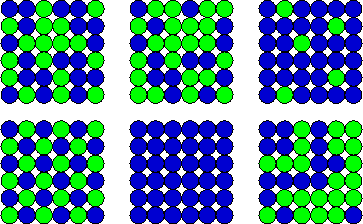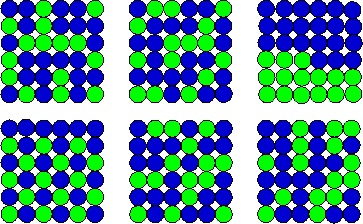Imagine we have counters, blue on one side and green on the other, and we toss them and place them on a ![]() checkerboard. Full information involves listing the colour at each site: this is the equivalent of a microstate.
checkerboard. Full information involves listing the colour at each site: this is the equivalent of a microstate.
Many different patterns are possible, such as the following. Every configuration is equally likely--or unlikely--to
occur: There are
![]() patterns and the the probability of each is
patterns and the the probability of each is
![]() . (This satisfies the ``postulate of equal a priori probabilities''.)
. (This satisfies the ``postulate of equal a priori probabilities''.)

Suppose from a distance we only knew how many counters were green and how many blue, without being able to distinguish different arrangements of the same numbers of counters. Then a ``macrostate'' would be characterised simply by the total number of green counters (the rest being blue).
Clearly, most macrostates correspond to many microstates. If the macroscopic description is ``15 green'', the following are a few of the allowed microstates:

How many are there in total? This is the common problem of splitting a group of ![]() into two smaller groups,
of
into two smaller groups,
of ![]() and
and ![]() , without caring about the ordering in each group, and the number of ways of doing it is
, without caring about the ordering in each group, and the number of ways of doing it is
The numbers
![]() are called the binomial coefficients (since they enter the binomial expansion)
and they are written
are called the binomial coefficients (since they enter the binomial expansion)
and they are written ![]() or
or ![]() .
.